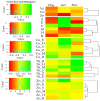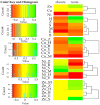Mitigation of the Adverse Impact of Copper, Nickel, and Zinc on Soil Microorganisms and Enzymes by Mineral Sorbents
- PMID: 35955133
- PMCID: PMC9369485
- DOI: 10.3390/ma15155198
Mitigation of the Adverse Impact of Copper, Nickel, and Zinc on Soil Microorganisms and Enzymes by Mineral Sorbents
Abstract
Despite numerous studies on the influence of heavy metals on soil health, the search for effective, eco-friendly, and economically viable remediation substances is far from over. This encouraged us to carry out a study under strictly controlled conditions to test the effects of Cu2+, Ni2+, and Zn2+ added to soil in amounts of 150 mg·kg-1 d.m. of soil on the soil microbiome, on the activity of two oxidoreductases and five hydrolases, and on the growth and development of the sunflower Helianthus annunus L. The remediation substances were a molecular sieve, halloysite, sepiolite, expanded clay, zeolite, and biochar. It has been demonstrated that the most severe turbulences in the soil microbiome, its activity, and the growth of Helianthus annunus L. were caused by Ni2+, followed by Cu2+, and the mildest negative effect was produced by Zn2+. The adverse impact of heavy metals on the soil microbiome and its activity was alleviated by the applied sorbents. Their application also contributed to the increased biomass of plants, which is significant for the successful phytoextraction of these metals from soil. Irrespective of which property was analysed, sepiolite can be recommended for the remediation of soil polluted with Ni2+ and zeolite-for soil polluted with Cu2+ and Zn2+. Both sorbents mitigated to the highest degree disturbances caused by the tested metals in the soil environment.
Keywords: Helianthus annuus L.; heavy metals; soil enzymes; soil microbiome; sorbents.
Conflict of interest statement
The authors declare no conflict of interest. The funders had no role in the design of the study; in the collection, analyses, interpretation of data; in the writing of the manuscript; or in the decision to publish the results.
Figures








Similar articles
-
Evaluation of the Usefulness of Sorbents in the Remediation of Soil Exposed to the Pressure of Cadmium and Cobalt.Materials (Basel). 2022 Aug 19;15(16):5738. doi: 10.3390/ma15165738. Materials (Basel). 2022. PMID: 36013875 Free PMC article.
-
Molecular Sieve, Halloysite, Sepiolite and Expanded Clay as a Tool in Reducing the Content of Trace Elements in Helianthus annuus L. on Copper-Contaminated Soil.Materials (Basel). 2023 Feb 23;16(5):1827. doi: 10.3390/ma16051827. Materials (Basel). 2023. PMID: 36902943 Free PMC article.
-
An Evaluation of the Effectiveness of Sorbents in the Remediation of Soil Contaminated with Zinc.Water Air Soil Pollut. 2018;229(7):235. doi: 10.1007/s11270-018-3882-2. Epub 2018 Jul 1. Water Air Soil Pollut. 2018. PMID: 30046198 Free PMC article.
-
A critical review of the bioavailability and impacts of heavy metals in municipal solid waste composts compared to sewage sludge.Environ Int. 2009 Jan;35(1):142-56. doi: 10.1016/j.envint.2008.06.009. Epub 2008 Aug 8. Environ Int. 2009. PMID: 18691760 Review.
-
Enhancing phytoextraction: the effect of chemical soil manipulation on mobility, plant accumulation, and leaching of heavy metals.J Environ Qual. 2003 Nov-Dec;32(6):1939-54. doi: 10.2134/jeq2003.1939. J Environ Qual. 2003. PMID: 14674516 Review.
Cited by
-
The Effect of Spring Barley Fertilization on the Content of Polycyclic Aromatic Hydrocarbons, Microbial Counts and Enzymatic Activity in Soil.Int J Environ Res Public Health. 2023 Feb 21;20(5):3796. doi: 10.3390/ijerph20053796. Int J Environ Res Public Health. 2023. PMID: 36900816 Free PMC article.
-
Sensitivity of Zea mays and Soil Microorganisms to the Toxic Effect of Chromium (VI).Int J Mol Sci. 2022 Dec 22;24(1):178. doi: 10.3390/ijms24010178. Int J Mol Sci. 2022. PMID: 36613625 Free PMC article.
-
The Usability of Sorbents in Restoring Enzymatic Activity in Soils Polluted with Petroleum-Derived Products.Materials (Basel). 2023 May 15;16(10):3738. doi: 10.3390/ma16103738. Materials (Basel). 2023. PMID: 37241368 Free PMC article.
-
The Impact of Permethrin and Cypermethrin on Plants, Soil Enzyme Activity, and Microbial Communities.Int J Mol Sci. 2023 Feb 2;24(3):2892. doi: 10.3390/ijms24032892. Int J Mol Sci. 2023. PMID: 36769219 Free PMC article.
References
-
- Arthur M.J.R., Yuan W., Wang D., Wang D., Kumar A. The effect of gasification conditions on the surface properties of biochar produced in a top-lit up draft gasifier. Appl. Sci. 2020;10:688. doi: 10.3390/app10020688. - DOI
-
- El-Naggar A., Lee M.-H., Hur J., Lee Y.H., Igalavithana A.D., Shaheen S.M., Ryu C., Rinklebe J., Tsang D.C.W., Ok Y.S. Biochar-induced metal immobilization and soil biogeochemical process: An integrated mechanistic approach. Sci. Total Environ. 2020;698:134112. doi: 10.1016/j.scitotenv.2019.134112. - DOI - PubMed
-
- Doran J.W., Zeiss M.R. Soil health and sustainability: Managing the biotic component of soil quality. Appl. Soil Ecol. 2000;15:3–11. doi: 10.1016/S0929-1393(00)00067-6. - DOI
Grants and funding
LinkOut - more resources
Full Text Sources

